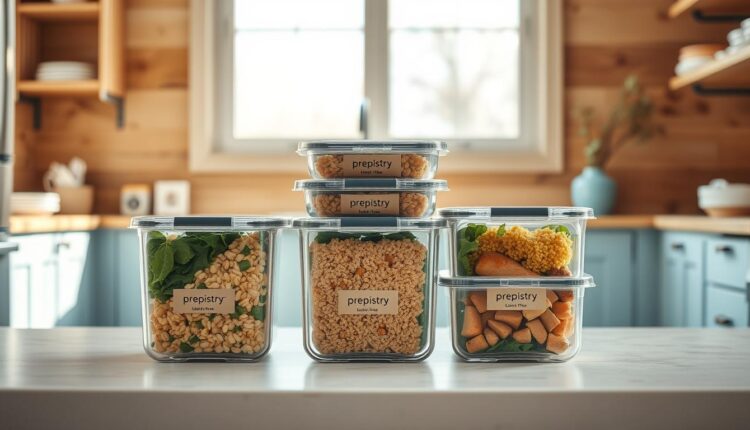Gluten Free Lunch Meal Prep Ideas Safe For Celiacs
Master gluten free lunch meal prep with our practical tips and recipes. Perfect for busy families and professionals seeking safe meal solutions.
What if your midday meal could be both delicious and stress-free—without compromising safety? For those managing celiac needs, creating satisfying dishes requires more than just avoiding certain ingredients. It’s about building a system that works seamlessly, even on chaotic days.
In my years of helping families and professionals simplify their kitchens, I’ve learned one truth: successful planning starts with trust. Trust in recipes that won’t cross-contaminate. Trust in flavors that keep lunch exciting. This guide shares practical strategies I’ve tested myself—like how to batch-cook quinoa bowls or assemble vibrant salads that stay crisp for days.
We’ll explore fresh ingredient swaps, storage hacks for busy schedules, and how to balance nutrition without sacrificing taste. Whether you’re new to dietary restrictions or refining your routine, these ideas prioritize safety and satisfaction. Let’s build a lunch rhythm that fits your life—one airtight container at a time.
- Proven methods to avoid cross-contamination during prep
- Time-saving techniques for flavorful, safe dishes
- Storage solutions that maintain texture and freshness
Embracing a Gluten Free Lifestyle for Celiac Safety
When my diagnosis came, I realized safety and taste could coexist with the right strategies. Early on, I swapped sandwich bread for corn tortillas and discovered roasted potatoes make hearty bases for bowls. It wasn’t about losing favorites—it was about gaining confidence in every bite.
Balancing midday and evening meals became simpler with lighter options. A vibrant salad with grilled chicken keeps energy steady, while dinner might feature tamari-marinated tofu over quinoa. This approach avoids the dreaded 3 PM slump many of us face.
“Always read labels twice—even ‘safe’ products can change formulations,”
These trusted swaps became my kitchen staples:
| Common Ingredient | Safe Substitute | Why It Works |
|---|---|---|
| Wheat-based soy sauce | Tamari | Rich umami without additives |
| All-purpose flour | Potato starch | Creates crisp coatings |
| Croutons | Toasted chickpeas | Adds crunch + protein |
Experimenting with alternatives like lentil-based crispbread transformed my routine. Friends now request my sun-dried tomato hummus recipe—proof that restrictions can spark creativity. Start with one swap this week and notice how your body responds.
Smart ingredient swaps can make your gluten-free journey flavorful and stress-free—no need to sacrifice taste or safety.
The Gluten Free Diet and Its Benefits
Did you know 1 in 100 people worldwide have celiac disease? For them, avoiding wheat isn’t a trend—it’s a necessity. A strict diet eliminates barley, rye, and contaminated oats while focusing on whole foods like veggies, lean meats, and safe grains.
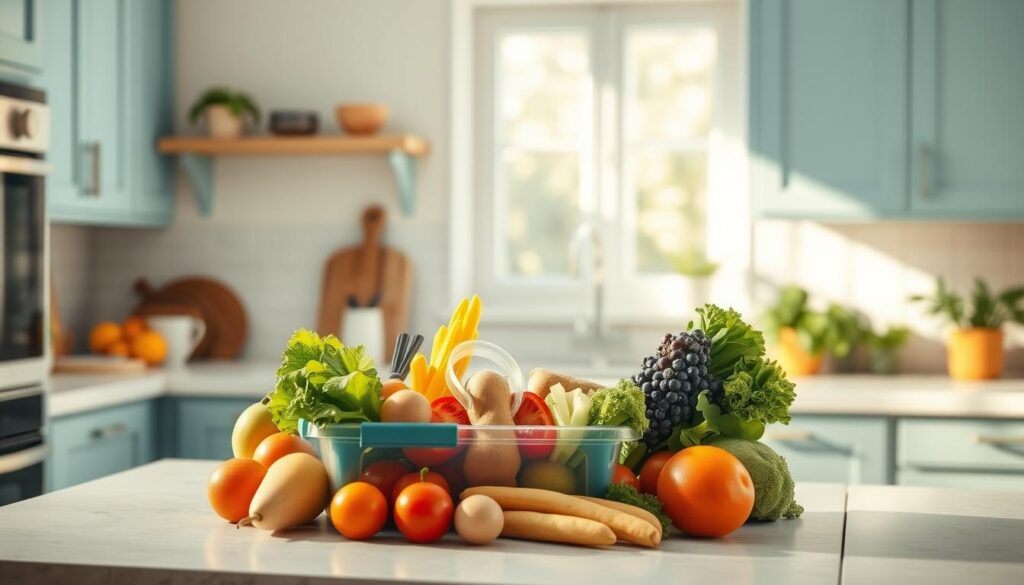
Switching from traditional carbs can boost energy and digestion. Research shows replacing refined bread with roasted potatoes increases fiber intake by 40%. Pairing these with grilled chicken creates balanced meals that keep you full longer.
Here’s how common swaps stack up nutritionally:
| Traditional | Alternative | Key Benefit |
|---|---|---|
| White bread | Mashed sweet potato | Higher vitamin A |
| Pasta | Cauliflower rice | Lower calories |
| Crackers | Roasted chickpeas | Extra protein |
One client told me, “Using corn tortillas instead of sandwiches helped me lose 12 pounds without feeling deprived.” Lean proteins like baked chicken thighs become flavor carriers when seasoned well—try smoked paprika or citrus marinades.
Always check labels for hidden wheat derivatives. With smart swaps, you’ll discover meals that protect your health and excite your taste buds.
Be cautious when reading labels—ingredients can change formulations, even in trusted products. Always double-check.
Planning Your Weekly Meal Prep Strategy
Ever found yourself staring into the fridge at noon, wishing lunch would magically assemble itself? Let’s turn that wish into reality with a system I’ve perfected through years of trial—and plenty of burnt quinoa.
Start by choosing one weekend hour to map your meals. I use this 3-step rhythm:
- Thursday: Inventory check + grocery list
- Saturday: Batch-cook bases (2 sheet pans of diced potatoes, 3 cups quinoa)
- Sunday: Assemble 4-5 containers with proteins/veggies
Roast potatoes at 425°F while quinoa simmers—they’ll finish around the same time. Store them separately to maintain texture. For proteins, bake chicken thighs alongside tofu cubes seasoned with smoked paprika.
My current favorite combo: lemon-herb chicken, roasted red peppers, and garlicky greens over fluffy quinoa. It takes 15 minutes to portion into containers if everything’s pre-prepped.
“I dedicate 90 minutes weekly—less time than I used to spend deciding what to order.”
Invest in glass containers with dividers to keep components crisp. Label lids with dates using dry-erase markers. Need a speed boost? Chop veggies during Netflix time or use a rice cooker for perfect grains hands-free.
Cross-contamination is a serious risk—ensure your kitchen tools and surfaces are properly cleaned before each prep.
Essential Gluten Free Ingredients and Kitchen Tools
Your knife glides through crisp veggies as the aroma of fresh basil fills the air—this is where great meals begin. Building a reliable pantry and toolkit transforms chaotic cooking into joyful creation.

Flavor Builders Worth Stocking
Extra virgin olive oil became my secret weapon after discovering its versatility. Drizzle it over roasted vegetables or whisk with lemon for vibrant dressings. Fresh spinach adds color and nutrients to bowls, while homemade sauces like tahini-garlic blend elevate simple proteins.
Tools That Earn Their Counter Space
A sharp chef’s knife cuts prep time in half—I regretted cheap versions until investing in one quality blade. Glass containers with tight seals keep dressings from leaking, and color-coded cutting boards prevent cross-contact. My rice cooker doubles as a quinoa steamer for hands-free cooking.
Pro tip: Buy nuts and seeds in bulk for affordable crunch. Store them in clear jars for easy grabbing. When your tools and ingredients work together, you’ll spend less time prepping and more time savoring.
Avoid assuming ‘gluten-free’ products are safe for everyone—always verify ingredient sources and manufacturing processes.
Mastering Gluten Free Lunch Meal Prep: Tools and Techniques
The sizzle of roasted vegetables hitting a hot pan signals the start of something good. Let’s talk about the tools that turn chaos into calm—like my favorite divided containers that keep dressings separate until you’re ready to eat. Multifunctional gear saves time: a spiralizer creates zucchini noodles for salads and veggie-packed breakfast bowls in minutes.
Breakfast ideas often double as lunch starters. Whip up egg muffins with spinach on Sunday—they’re portable morning fuel and transform into salad toppings later. Add sliced cucumber and a lemon wedge to brighten leftovers. One client told me, “Using muffin tins for individual portions changed my weekly routine—no more soggy containers!”
Three tools that earn their keep:
- Steamer basket: Perfect for reheating without drying out proteins
- Citrus squeezer: Adds fresh lemon juice to grain bowls in seconds
- Collapsible colander: Saves space when prepping veggies
| Challenge | Solution | Why It Works |
|---|---|---|
| Soggy textures | Paper towel layer under veggies | Absorbs excess moisture |
| Bland flavors | Lemon zest in dressings | Boosts brightness |
| Portion confusion | Color-coded lids | Identifies meals quickly |
“My glass containers go from fridge to microwave without transferring dishes—game changer for office days.”
Experiment with layering: crunchy cucumbers at the bottom, proteins in the middle, herbs on top. A squeeze of lemon before sealing keeps colors vibrant. Start with one new technique this week—you’ll taste the difference.
Quick and Easy Gluten Free Recipes for Busy Days
Ever raced against the clock to assemble something nourishing between Zoom calls? I’ve perfected five recipes that take less time than scrolling delivery apps. Start with pantry staples like canned tuna and fresh cherry tomatoes—they’re weeknight heroes waiting to shine.
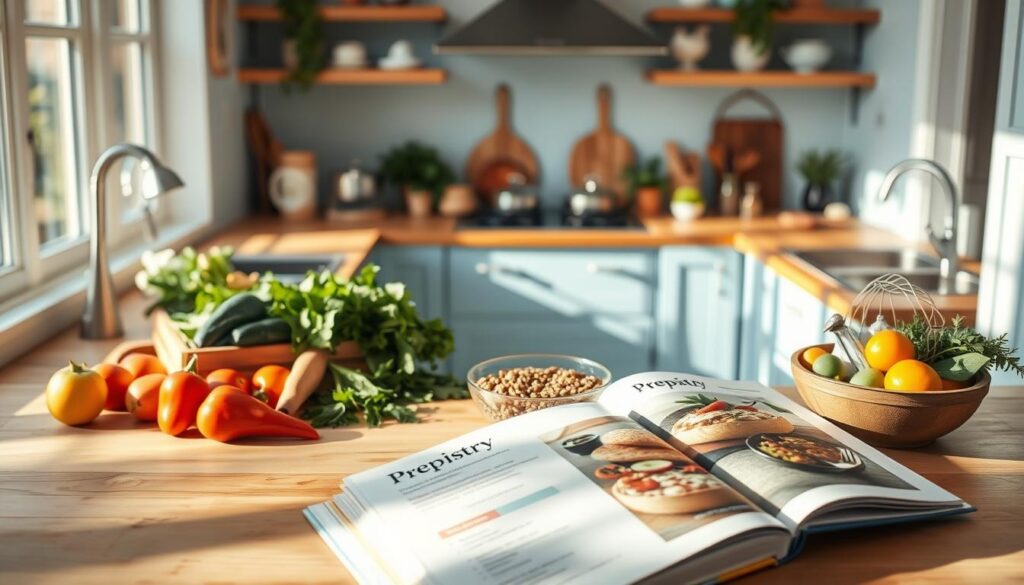
My go-to tuna salad combines lemon zest, diced celery, and olive oil-packed fish. Serve it on lentil crispbread with sliced cucumbers for crunch. Leftover rice transforms into fried “rice” bowls when sautéed with garlic, scrambled eggs, and frozen peas.
| Recipe | Key Ingredients | Time |
|---|---|---|
| Mediterranean Chickpea Bowl | Cherry tomatoes, olives, feta | 12 minutes |
| Zesty Lime Shrimp Tacos | Corn tortillas, avocado, cilantro | 15 minutes |
| Caprese Skewers | Mozzarella balls, basil, balsamic | 8 minutes |
During hectic work-from-home days, I prep components separately. Roast a tray of grape tomatoes while answering emails—they’ll caramelize into sweet bursts for grain bowls or breakfast meal prep scrambles. Lean proteins like rotisserie chicken speed up dinners without extra effort.
“These recipes helped me ditch takeout—even my kids ask for seconds!”
Adapt flavors to your mood: swap lime for orange in dressings, or add chili flakes to chickpeas. Every dish balances vibrant produce with satisfying textures. Remember, good food doesn’t require complexity—just smart pairings and a well-stocked spice rack.
Creative Salad and Bowl Ideas for Every Meal
Picture opening your fridge to a rainbow of fresh ingredients ready to transform into vibrant meals. Building satisfying salads and grain bowls starts with balancing colors, textures, and flavors—no culinary degree required. Let’s explore combinations that turn routine into excitement.
Refreshing Salad Combinations That Satisfy
Start with roasted sweet potato cubes as your base—their natural sweetness pairs perfectly with tangy dressings. Toss them with massaged kale, toasted pecans, and dried cranberries for a sweet-savory crunch. Add cooked quinoa or brown rice for staying power.
Try these winning pairings:
| Salad Name | Base Ingredients | Prep Tip |
|---|---|---|
| Southwest Sweet Potato Bowl | Black beans, avocado, lime | Roast veggies Sunday night |
| Citrus Kale & Quinoa | Mandarin oranges, red onion | Massage kale with dressing |
| Berry Spinach Power Bowl | Fresh strawberries, goat cheese | Layer nuts on top last |
“I prep 3 dressings each Sunday—balsamic, honey mustard, and tahini. They make every combo feel new.”
For texture contrast, keep crispy elements like jicama or radishes separate until serving. Store dressings in small containers to prevent sogginess. Need speed? Use pre-chopped veggies or leftover roasted chicken from last night’s dinner.
Rotate seasonal produce to keep your rotation fresh. Summer might mean grilled zucchini ribbons, while fall welcomes roasted Brussels sprouts. Variety isn’t just tasty—it ensures you’re getting diverse nutrients all week.
Transforming Leftovers into Delicious New Dishes
That container of last night’s roasted vegetables isn’t just leftovers—it’s tomorrow’s flavor-packed frittata waiting to happen. With a few smart tweaks, yesterday’s dinner becomes today’s star. Let me show you how to breathe new life into what’s already in your fridge.
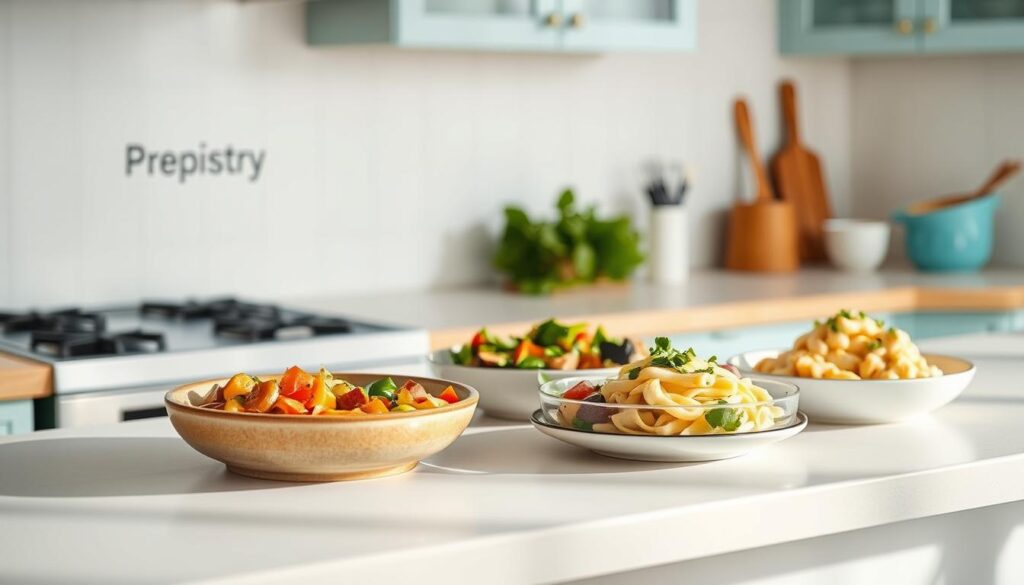
Start by treating leftovers as building blocks. Chopped grilled chicken morphs into tacos when paired with corn tortillas and lime. Stale rice? Sauté it with garlic and frozen peas for a fried rice base. Here’s my three-step reset:
- Chop & Refresh: Add fresh herbs or citrus zest to brighten flavors
- Mix & Match: Combine proteins with new grains or veggies
- Heat & Crisp: Reheat in a skillet instead of the microwave for better texture
Take that leftover rice and meatballs example. Toss them with spinach and crumbled feta, then drizzle with olive oil. You’ve got a Mediterranean-inspired bowl in 6 minutes flat. Cheese works wonders here—shredded cheddar transforms mashed potatoes into crispy croquettes, while goat cheese elevates roasted veggie wraps.
| Leftover | Transformation | Time Saved |
|---|---|---|
| Roasted Chicken | Chicken salad with grapes | 10 minutes |
| Steamed Broccoli | Broccoli cheddar soup | 15 minutes |
| Quinoa | Stuffed bell peppers | 20 minutes |
“Repurposing last night’s salmon into fish cakes cut my Wednesday cooking time in half—now I actually enjoy leftovers!”
Planning just one “remix” meal weekly reduces food waste and grocery bills. Store components separately for maximum flexibility. Your future self will thank you when 5 PM hits and dinner’s already halfway done.
Incorporating Protein: Chicken, Tofu, Egg, and More
Protein keeps your energy steady from breakfast through dinner—no mid-afternoon crashes allowed. Let’s talk about building meals that satisfy and sustain. My kitchen rule? Always pair proteins with vibrant veggies like massaged kale for balance.
Chicken thighs become flavor magnets when marinated in tamari, honey, and garlic. Bake them at 400°F for 25 minutes—juicy every time. For plant-based options, try crispy baked tofu cubes tossed in sesame oil and smoked paprika. Eggs? Hard-boiled ones make grab-and-go snacks or salad toppers.
Three protein prep methods I swear by:
- Batch-bake: Cook 2 lbs of chicken Sunday night for 3 meals
- Press & cube: Remove tofu moisture for better texture
- Boil & peel: Prep eggs in ice water for easy shell removal
| Protein | Cooking Time | Best Pairing |
|---|---|---|
| Chicken thighs | 25 minutes | Roasted sweet potatoes |
| Chickpeas | 15 minutes | Massaged kale salad |
| Egg muffins | 20 minutes | Sliced avocado |
“Marinate proteins in glass jars—they stack neatly and infuse flavor overnight.”
For quick lunches, mix shredded chicken with mashed chickpeas and lemon zest. Stuff into lettuce wraps with shredded carrots. Need crunch? Top with toasted sunflower seeds. Rotate seasonings weekly—try turmeric for eggs or ginger-lime for tofu.
Exploring Versatile Carbs: Quinoa, Rice, Potatoes, and Sweet Potato
The secret to satisfying meals lies beneath their vibrant toppings—a foundation of hearty, versatile carbs. Let’s explore four staples that transform simple ingredients into nourishing dishes. Each brings unique textures and benefits to your plate.
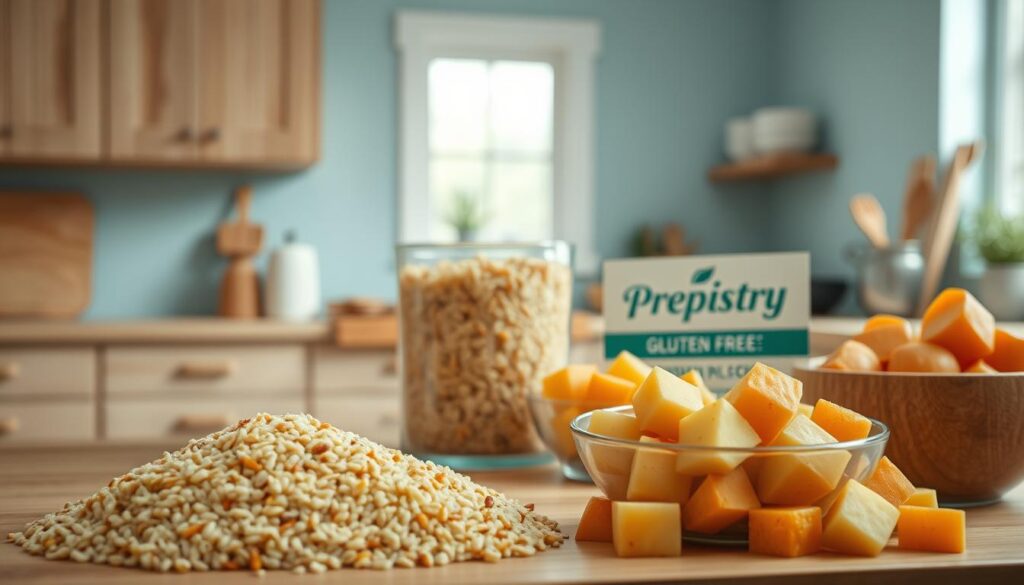
Quinoa’s nutty flavor and protein boost make it ideal for grain bowls. Cook it in broth instead of water for extra richness. Rice offers comfort—try jasmine for floral notes or brown for chewiness. Potatoes? Roast them crispy or mash with garlic for creamy texture. Sweet potatoes add natural sweetness and vitamin A when baked with olive oil.
| Carb | Best Use | Prep Tip |
|---|---|---|
| Quinoa | Protein-packed salads | Rinse thoroughly to remove bitterness |
| Basmati Rice | Stir-fries | Add lime zest while cooking |
| Sweet Potato | Breakfast hash | Cube and roast with smoked paprika |
Pair these bases with bold sauces. A mango salsa brightens quinoa, while cilantro-lime dressing elevates rice bowls. For potatoes, try a yogurt-based sauce with dill. Batch-cook grains on Sundays—store them in portioned containers for quick assembly.
“I keep cooked rice frozen in muffin tins—perfect single servings for make-ahead breakfast scrambles or last-minute dinners.”
Combine carbs with proteins and veggies for balance. Layer roasted sweet potatoes with black beans and avocado. Toss chilled rice with edamame and sesame seeds. Every dish becomes a canvas for creativity.
Fresh and Flavorful Gluten Free Salads for Lunch and Dinner
Crisp greens meet jewel-toned veggies in a bowl that’s as vibrant as your favorite farmer’s market haul. Start with peppery arugula or butter lettuce as your base—their bold textures hold up beautifully under dressings. I layer mine with roasted red peppers, cucumber ribbons, and avocado slices for contrasting crunch and creaminess.
| Base | Toppings | Dressing |
|---|---|---|
| Massaged kale | Chickpeas, roasted peppers, feta | Lemon-tahini |
| Spinach blend | Grilled chicken, strawberries, almonds | Balsamic reduction |
| Romaine hearts | Black beans, corn, jicama | Cilantro-lime crema |
Keep components crisp by storing dressings separately. I tuck mine in small jars or silicone cupcake liners. For cream-based sauces, a dollop of Greek yogurt adds tang without heaviness. “Adding toasted pepitas transformed my salads from sad to spectacular,” shared a client who now meal preps mason jar versions.
Build layers strategically: hearty veggies at the bottom, proteins in the middle, delicate herbs on top. Toss in fresh basil or mint just before eating. Need a flavor boost? Shave Parmesan over warm roasted veggies—it melts slightly for luxurious texture.
- Chop crunchy elements (radishes, peppers) thicker than soft ingredients
- Blanch green beans or broccoli to maintain bright color
- Use leftover grains as edible “bowls” for easy cleanup
These combinations work equally well for quick desk lunches or light dinners. Pair with grilled shrimp or white beans for added protein. The best part? You’re just seven ingredients away from a salad that tastes like it came from your favorite bistro.
Homemade Sauces and Dressings: Elevate Your Meal Prep
Your fork hits a burst of flavor that makes you pause—was that hint of roasted garlic or the fresh basil? That’s the magic of DIY sauces. Store-bought dressings often hide unnecessary additives, but crafting your own lets you control both safety and taste. I keep a rotation of five bases in my fridge, ready to transform simple ingredients into restaurant-worthy dishes.
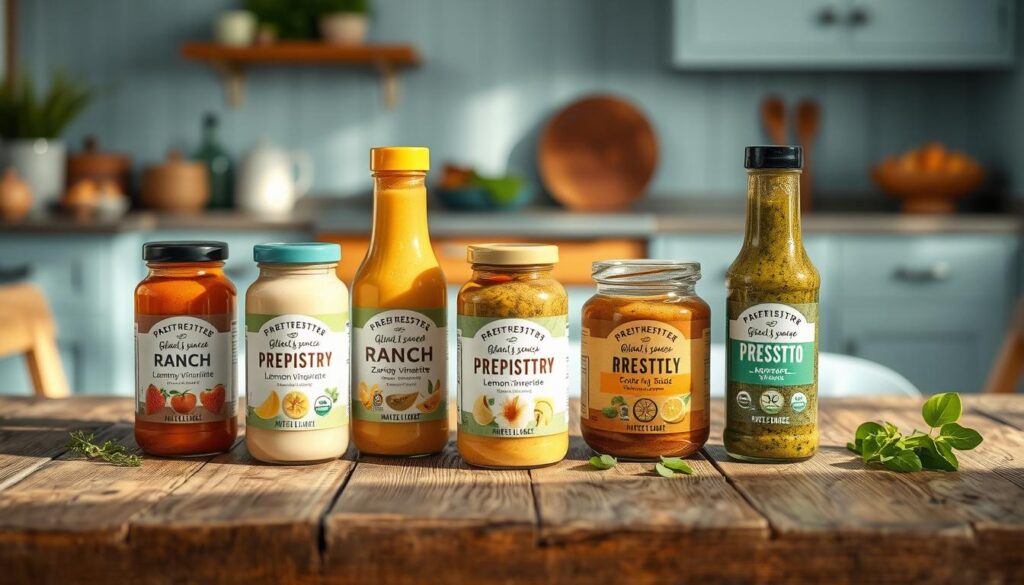
Quick Homemade Vinaigrettes for Salads
Start with this lemon-herb staple: whisk ¼ cup olive oil with 2 tbsp fresh citrus juice, 1 tsp Dijon mustard, and a handful of chopped parsley. For creamy variations, blend cooked corn kernels into the mix—their natural sweetness balances tangy vinegar perfectly. Chickpeas also work wonders when pureed with tahini and roasted garlic.
| Base | Add-In | Flavor Boost |
|---|---|---|
| Balsamic | Roasted red peppers | Smoked paprika |
| Apple cider | Steamed carrots | Ground ginger |
| Rice vinegar | Blended chickpeas | Sesame oil |
Customizing Sauces to Boost Flavor
Turn leftover roasted vegetables into vibrant dressings. Blend steamed cauliflower with nutritional yeast for a cheese-like sauce, or mix charred corn with lime for taco bowls. Batch-prep four small jars each Sunday—label them with masking tape and dates.
“My roasted red pepper sauce doubles as a dip for raw veggies and marinade for chicken—three uses from one blender jar!”
Adapt classic recipes by swapping soy sauce with tamari or using cornstarch instead of flour. Need ideas? Try adding pureed spinach to pesto for extra nutrients or mixing mashed chickpeas into ranch for protein-packed crunch. Your creations will make every container something to anticipate.
Organizing Your Kitchen: Containers and Time Management Tips
Ever opened three containers only to find wilted greens? A well-planned kitchen setup turns chaos into calm. Start with stackable glass containers—they let you see ingredients at a glance and prevent the “mystery leftovers” dilemma. Families juggling multiple schedules benefit most from clear systems that keep everyone nourished without last-minute scrambles.
Choose containers with tight seals to lock in freshness. Divided compartments keep dressings separate from delicate greens. For diced onions or chopped herbs, use small jars to preserve their crunch. Busy households save 15+ minutes daily by prepping a bunch of veggies upfront—store them in labeled bins for grab-and-go ease.
| Container Type | Best For | Pro Tip |
|---|---|---|
| Glass with Dividers | Complete meals | Layer dressings at the bottom |
| Silicone Bags | Snacks & herbs | Freeze a bunch of basil for sauces |
| Mason Jars | Layered salads | Put hearty veggies at the base |
Time management starts with a Sunday reset. Dice a week’s worth of onions and bell peppers while listening to a podcast. One parent shared, “Prepping aromatics in bulk cut my dinner prep from 30 minutes to 10.” Use color-coded labels for allergens or meal days—blue for Monday’s chicken bowls, green for Wednesday’s stir-fry.
- Store similar items together: oils near spices, grains beside canned beans
- Keep a “use first” bin for perishables like fresh herbs
- Assign family members specific tasks (teen chops veggies, partner labels containers)
“Labeling transformed my fridge—no more guessing if that’s cilantro or parsley!”
Even small kitchens thrive with vertical storage. Mount a rack for lids or use drawer dividers for measuring spoons. The goal? Create a flow that makes cooking feel effortless, not exhausting.
Gluten Free Meal Prep Tips for Busy Families and Professionals

Thursday’s roasted veggies can become Friday’s vibrant wrap with a few simple twists. Start by designating Sunday afternoons for batch-cooking proteins and grains—this creates building blocks for fast midday meals. Store components in clear containers labeled with dates to streamline morning routines.
| Leftover Ingredient | Transformation Idea | Time Saved |
|---|---|---|
| Rotisserie chicken | BBQ chicken lettuce wraps | 8 minutes |
| Steamed quinoa | Stuffed bell peppers | 12 minutes |
| Roasted sweet potatoes | Breakfast hash + fried eggs | 6 minutes |
Create snack plates that appeal to all ages. Combine apple slices, cheese cubes, and toasted pumpkin seeds in compartmentalized containers. For crunch without crumbs, try baked lentil chips instead of crackers.
“I prep taco fillings on Sunday—seasoned ground turkey, shredded lettuce, and salsa. My kids assemble their own lunches while I’m answering emails.”
Three texture-boosting tricks:
- Keep crispy elements (radishes, jicama) separate until serving
- Toss grains with lemon juice to prevent clumping
- Freeze smoothie packs for grab-and-go breakfast meal prep
Label one shelf in your fridge for “lunch-ready” items—pre-chopped veggies, hard-boiled eggs, and dressings. This visual system helps hurried family members build balanced plates without rummaging.
Strategies to Overcome Gluten Free Meal Prep Challenges
Ever faced a fridge full of ingredients but zero inspiration? Let’s tackle common kitchen hurdles with smart fixes. Start by planning two “flex meals” weekly—dishes that adapt to whatever proteins or veggies you have. Rotisserie chicken becomes tacos one night and fried rice the next.
When pantry staples run low, improvise. Swap breadcrumbs with crushed rice cereal for meatball binders. No fresh herbs? Use dried oregano mixed with lemon zest. Keep a backup list of 5-minute meals like scrambled eggs with salsa or tuna-stuffed avocados.
Three ways to revive repetitive dishes:
- Shred leftover meat into make-ahead breakfast frittatas
- Toss roasted veggies with different spices each use
- Layer components in new formats (bowls vs. wraps)
| Challenge | Quick Fix | Why It Works |
|---|---|---|
| Soggy textures | Store dressings separately | Preserves crunch |
| Bland flavors | Add citrus zest to grains | Brightens taste |
| Time crunch | Pre-chop onions/peppers | Cuts prep steps |
“Label containers with meal ideas—‘chicken for stir-fry’ beats ‘mystery meat’ every time.”
Turn mistakes into discoveries. Burned a batch of meatballs? Crumble them into soup for smoky depth. Keep a “test kitchen” notebook to track what works. Most importantly, celebrate small wins—like nailing a new sauce or mastering grain-free pizza crust.
Conclusion
Transforming your kitchen into a safe haven of flavor doesn’t require endless hours—just smart systems. Through batch cooking, airtight storage, and creative ingredient swaps, you’ll craft midday dishes that nourish both body and spirit. Remember those divided containers we discussed? They’re not just tools—they’re trust-builders for every bite.
Start small: pick one recipe from our roasted veggie collection or try tamari-marinated proteins. Notice how pre-chopped herbs and prepped grains streamline your mornings. Glass jars with colorful layers aren’t Instagram bait—they’re your ticket to stress-free afternoons.
Need inspiration? Explore our guide to strategic meal planning for more time-saving hacks. Share your quinoa bowl triumphs or clever leftover transformations in our community forum—we celebrate every victory here.
Your journey toward confident cooking begins today. One seasoned chicken thigh, one crisp salad jar, one satisfied smile at a time. What delicious discovery will you unearth next?
Vibrant Quinoa Power Bowl with Lemon-Tahini Dressing
A nourishing, gluten-free, and vegan-friendly bowl brimming with protein-rich quinoa, fresh vegetables, and a zesty lemon-tahini dressing. Perfect for meal prep or a wholesome lunch.
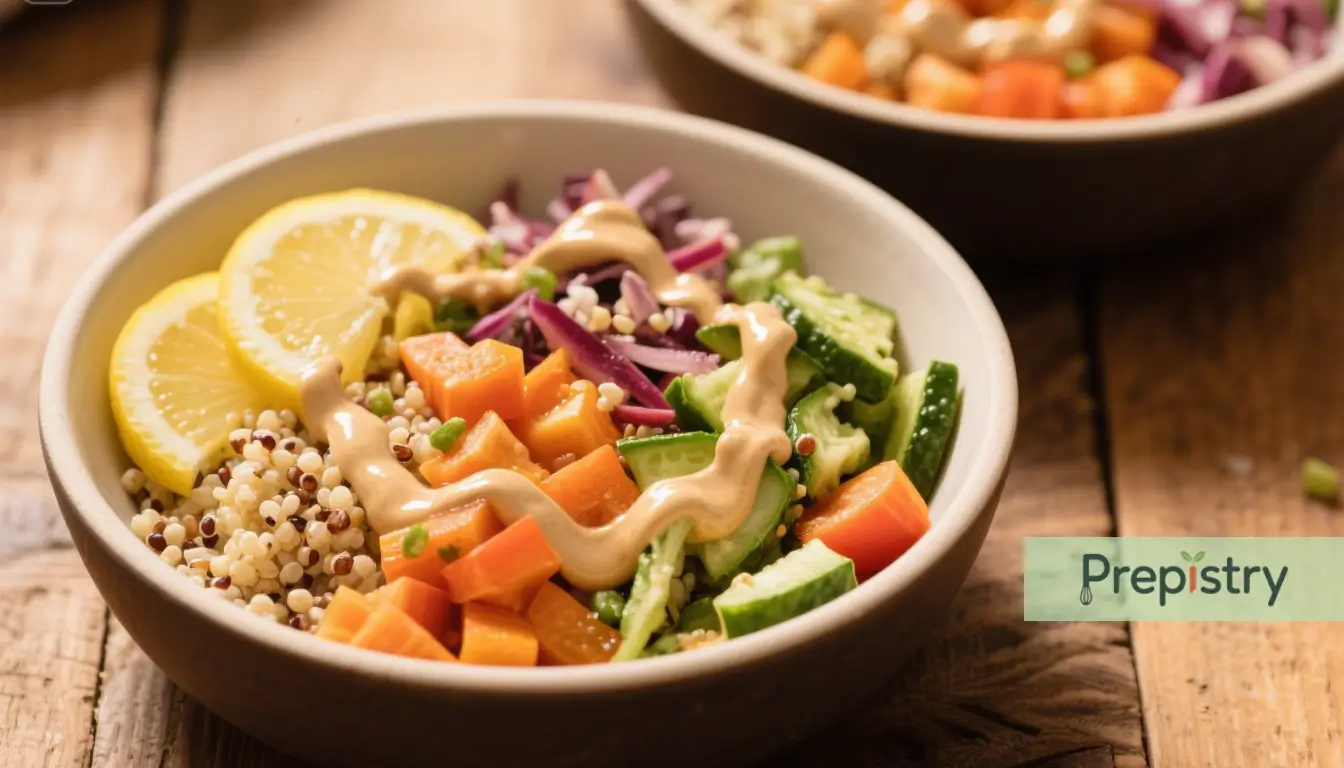
Nutrition Information
Equipment Needed
- medium saucepan
- baking sheet
- small bowl
- large mixing bowl
Ingredients
-
1 cup quinoa
-
2 cups water
-
1 tablespoon olive oil
-
1 cup sweet potato, peeled and diced
-
1 cup broccoli florets
-
1/2 cup red bell pepper, chopped
-
1/2 cup cherry tomatoes, halved
-
1/4 cup red onion, thinly sliced
-
1/4 cup pumpkin seeds, toasted
-
1/4 cup fresh cilantro, chopped
-
1/4 cup tahini
-
2 tablespoons lemon juice
-
1 tablespoon maple syrup
-
1 tablespoon apple cider vinegar
-
1/2 teaspoon garlic powder
-
Salt and pepper to taste
Instructions
Recipe Video
🥗 Quinoa Bowl with Tahini Dressing
🥗 Quinoa Bowl with Tahini Dressing Let’s hear it for the humble quinoa bowl 👏 Loaded with roasted veggies + creamy tahini dressing = a bowl I’ll never get tired of. 🌱 Vegan | Gluten-Free | Meal Prep-Friendly Serves: 4 | Time: 1 hour Ingredients: • 9 oz. quinoa (uncooked) • 1 red onion, chopped • 1 green bell pepper, chopped • 14 oz. pumpkin, cubed • ½ tsp. garlic powder • ½ tsp. dried oregano • 4 tbsp. parsley, chopped • Tahini dressing (for drizzling) How to Make It: 1️⃣ Cook quinoa with salt and water. Fluff with a fork. 2️⃣ Roast veggies at 425°F with olive oil + spices for 30 min. 3️⃣ Broil for 5 mins for extra golden goodness. 4️⃣ Assemble: Quinoa ➡️ Roasted Veg ➡️ Parsley ➡️ Tahini Drizzle ✨

